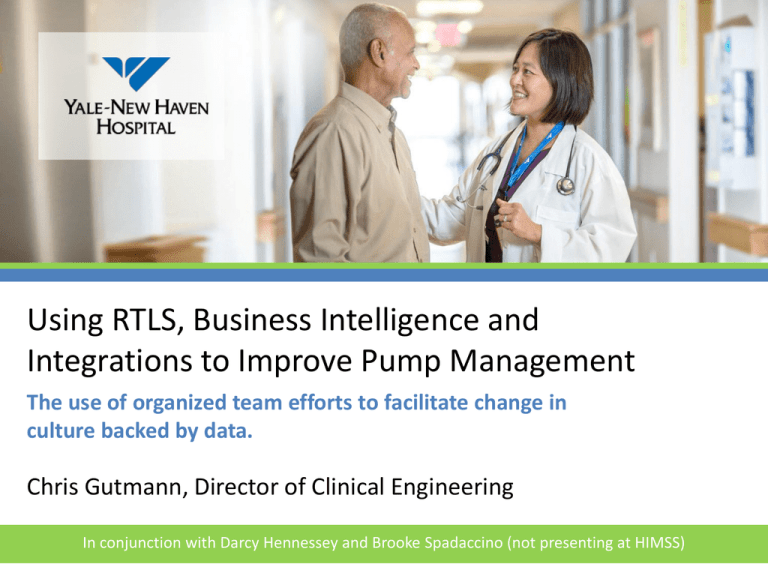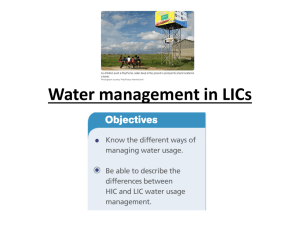Using RTLS, Business Intelligence and Integrations to Improve
advertisement

Using RTLS, Business Intelligence and Integrations to Improve Pump Management The use of organized team efforts to facilitate change in culture backed by data. Chris Gutmann, Director of Clinical Engineering In conjunction with Darcy Hennessey and Brooke Spadaccino (not presenting at HIMSS) Project Goals Ensure EVERY patient will have a pump when needed Multi Disciplinary Team: • • • Materials Management Pharmacy Information Services • • • Nursing Clinical Engineering Operations Support How will we achieve this? • • • • • Staff will readily release pumps when not in use Pumps will be available when they call/request Patients will arrive on units from procedure areas/OR’s /ED with pumps in place, ( receiving unit staff will give back a pump) Each area will have the appropriate “safety stock” for unexpected situations Identify the “safety stock" needed at entry points in the care continuum 2 Yale – New Haven Health System 2013 Yale New Haven Health System Profile k Yale-New Haven Bridgeport Hospital Hospital Greenwich Hospital NEMG YNHHS (Total) Total Licensed Beds* 1,541 383 206 -- 2,130 Average Daily Census 1,173.4 267.0 142.4 -- -- Inpatient Discharges 80,503 18,454 12,439 -- 11,396 Outpatient Encounters 1,085,738 242,784 296,673 -- 1,625,195 Total Assets $2.8 billion $443 million $566 million $26 million $3.8 billion Total Revenue** $2.4 billion $445 million $343 million $164 million $3.3 billion Medical Staff*** Employees**** 4,138 11,436 825 2,512 545 1,754 552 1,091 6,060 18529* 3 Y-NHH: A Tradition of Excellence Nursing continually looks to for opportunities of systems redesign which solidify our team approach. 4 Yale – New Haven Hospital The history of Yale-New Haven Hospital extends back to 1826 when the General Hospital Society of Connecticut was chartered as the first hospital in Connecticut and the fourth voluntary hospital in the nation. The hospital rented temporary quarters and raised US$5,000 toward purchase of land and construction. A new 13-bed hospital opened in 1833 on seven and a half acres of land bordered by Cedar Street and Howard, Davenport and Congress avenues. 2013: • 5 Million Square Feet owned and operated by YNHH • • • • • 4 main pavilions = 2,000,000 ft2 — 60 Operating Rooms, 25+ procedure rooms — 1,120 Patient Beds — Level 1 Trauma in Pediatrics and Adult Emergency Medicine Park St. - Lab and Pharmacy = 130K ft2 Physicians Building and Psych. Hospital = 100K ft2 Yale School of Medicine adjacent/attached to hospital Former Hospital of St. Raphael’s = 1,000,000 ft2 5 SOS Alert Continual crisis episodes sent routine alerts to the entire organization calling for pumps! Continual issues add to the alarm fatigue… Please call the SRC for pick-up now. 688-9000 6 Project Charter: Sigma Pump Participant/Process Representatives Project Sponsor: • Sue Fitzsimons – Chief Nursing Officer Process Owner: • Carol Just - Director, Surgical Services •Chris Gutmann – Director, Clinical Engineering Multi Disciplinary Team Members: • Clinical Engineering • Information Services • Materials Management • Nursing • Operations Support • Pharmacy Project Description / Problem Statement Cycle of distrust: Only broken when everyone cooperates Sigma pump equipment management including: • System to Locate Pumps does not identify “pump in use” • Procurement • Inability to get a pump when needed induces lack of trust in process and hiding of pumps • Hiding pumps lead to a shortage of pumps Project Goals Ensure EVERY patient will have a pump when needed. How will we achieve this? • Staff will readily release pumps when not in use • Pumps will be available when they call/request • Patients will arrive on units from procedure areas/OR’s /ED with pumps in place, ( receiving unit staff will give back a pump) • Preventative maintenance • Allocation for each clinical area Process Scope: In/Out In Scope: • York Street Campus, Saint Raphael Campus Out of Scope: • Bridgeport and Greenwich hospitals Project Y / Key Metrics • Sigma pump monthly call volume • Identify the “safety stock" needed at entry points in the care continuum • Sigma pump call volume by unit per month Call Service Response Center and/ or Off Shift Executive and/or Off Shift Nursing Leader to deliver pumps and/or go floor by floor in the hospital to collect unused pumps Store the pumps in a safe location in case they are need for the next patient • Movement throughout the hospital • Each area will have the appropriate “safety stock” for unexpected situations SIPOC / High Level Process Map for Unit Sigma pump needed but none available Process Scope: Start/end Remove the pump(s) from patient departing the unit • Average monthly Materials sigma pump job completion time Pump(s) received Place pump(s) on patient Customer CTQ’s Pump available when needed 7 Defining the Available Supply YNHH Average Monthly Census (by Calendar Year) Average Midnight Census 2008-09 2010 2011 2012 2013 1 900 UCL=904.5 _ X=878.3 850 LCL=852.0 800 1 750 700 8 t-0 Oc 9 r -0 Ap tOc 09 0 r- 1 Ap 0 t- 1 Oc 1 r -1 Ap 1 t-1 Oc 2 r- 1 Ap 2 t- 1 Oc 3 r- 1 Ap 1400 pumps purchased in 2009 no additions to date! 8 Sigma Pump Process Map 9 Do We Have Enough Pumps? All Stakeholders need to buy-in to the process… Vicious Cycle of Distrust: Snapshot of audit on 1/26/2012 (5am contact census 923) No equipment churn Staff Hoard equipment An episode of delay 1500 Crisis Calls per Month Equipment not available Patient criticality not driving need • Total in fleet – 1375 • Entry Points buffer - 359 – IR, HVC Labs, OR, PACU, – L&D & EDs – Oncology infusions 1375 (total) - 452 (noncirculating) = 923 Available • Remote Locations - 31 – Ambulatory, Psych – Dialysis, Pedi Clinic, Urgent care • Maintenance Process - 17 • Pumps in Waiting - 45 – Material’s pool for distribution 10 Defining the Demand Data Collection through the call center for materials and Baxter pump data on infusions started at entry points over the course of a day. 11 Streamlining the Movement Process 12 Streamlining the Movement Process Process for units: Process for SOS alert: • Unit leadership or • Rounding 3x daily assigned staff person to • Safety stock set as a profile round as soon as alert for each unit issued and check with all • 5S storage areas to define staff for unused sigma storage location of “safety pumps stock” • Place unused sigma • Unused clean equipment pumps in green bin and placed in green bins call SRC 688-9000 for • Units looks in green bin or pickup safety stock before calling materials for delivery Process for materials staff: • Check with charge RN that Process for EVS staff: safety stock (red tape with • Clean equipment is placed par number) is filled in green bin for pick up before removing sigma pumps from units • (no clean pumps to be left in rooms) • Collect equipment from green bin 13 Driving Results through Culture Change • In face of rising census the need to call the Service Response Center for pumps has decreased. • A plateau in reducing the number of calls for sigma pumps and are look to reinforce rounding and pilot technology to continue the downward trend. 14 14 State Monitoring -> Utilization At Material’s storage location in WP basement ready for shipment to unit Undergoing service at clinical engineering In transit for use In use at patient bedside Not in use, at patient bedside Not in use, in green bin or safety stock. Ready for usage by next patient 15 Score Card: Unit EP 7-7 SP 6-1 SP 6-4 Greens 12 23 16 Data Validation Pilot Asset ID Delivered Asset ID H50203G EPH50203G 7-7 EP 7-7 99% 1.50% 99% 1.50% 0% 0% 0% EPH51356G 7-7 EP 7-7 0% 100% 0% 100% 0% 0% 0% EPH53176G 7-7 EP 7-7 0% 0% 0% 0%0% 100% 0% H50273G EPH50273G 7-7 EP 7-7 0% 100% 0% 100% 0% 0% 0% • Running: time between the “start H51378G infusion” button is pressed and the H51475G H51035G pump completes drug delivery or is H50899G H50202G stopped H50183G H51179G • Not Running: amount of time the pump H50549G is not infusing H50537G H50393G • Available: amount of time the pump is H50551G physically in green bin or safety stock H51390G H50821G • Delivered: amount of time the pump H50548G H50703G travels from materials storage to a unit H50469G H50904G before used for an infusion EPH50360G 7-7 EP 7-7 57.97% 57.97% 42.03% 42.03% 0% 0% 0% EPH51378G 7-7 EP 7-7 3.90% 96.10% 3.90% 96.10% 0% 0% 0% EPH51475G 7-7 EP 7-7 45.77% 45.77% 54.23% 54.23% 0% 0% 0% EPH51035G 7-7 EP 7-7 84.35% 84.35% 15.65% 15.65% 0% 0% 0% EPH50899G 7-7 EP 7-7 63.68% 63.68% 36.32% 36.32% 0% 0% 0% EPH50202G 7-7 EP 7-7 9.69% 90.31% 9.69% 90.31% 0% 0% 0% EPH50183G 7-7 EP 7-7 100% 100% 0% 0%0% 0% 0% EPH51179G 7-7 EP 7-7 78.82% 78.82% 21.18% 21.18% 0% 0% 0% EPH50549G 7-7 EP 7-7 0% 100% 0% 100% 0% 0% 0% EPH50537G 7-7 EP 7-7 40.10% 40.10% 59.90% 59.90% 0% 0% 0% EPH50393G 7-7 EP 7-7 0% 100% 0% 100% 0% 0% 0% EPH50551G 7-7 EP 7-7 40.38% 40.38% 59.62% 59.62% 0% 0% 0% EPH51390G 7-7 EP 7-7 41.17% 41.17% 58.83% 58.83% 0% 0% 0% EPH50821G 7-7 EP 7-7 0% 0% 0% 0%0% 100% 0% EPH50548G 7-7 EP 7-7 0% 100% 0% 100% 0% 0% 0% EPH50703G 7-7 EP 7-7 0% 100% 0% 100% 0% 0% 0% EPH50469G 7-7 EP 7-7 0% 100% 0% 100% 0% 0% 0% EPH50904G 7-7 EP 7-7 18.34% 18.34% 81.66% 81.66% 0% 0% 0% H50862G EPH50862G 7-7 EP 7-7 0% 100% 0% 100% 0% 0% 0% H50534G EPH50534G 7-7 EP 7-7 72.83% 72.83% 27.17% 27.17% 0% 0% 0% Green Yellow Red Running > 2.4 hrs Reds 12 4 2 Not Running Available >12 hrs >18 hrs > 21.6 hrs >8hrsH51356G <18hrs H53176G >18 hrs H50360G Pilot participants: SP 6-1, SP 6-4 and EP 7-7 Running NotRunning Running Not Available Running Delivered Available Delivere 1 1 16 Dashboard Concept – Info @ Front Lines Actionable Data Pilot Studies on clinical units for profile setting of departments. Management Report Managers can view multiple floors to see a snapshot of the past 24 hours. 17 Demand is a function of Patient Acuity Worked with units individually to understand flow and patient acuity mix to set the proper PAR levels. SICU Not all units created equal… Step Down ORTHO 18 Improved Utilization Trust of the front line patient care groups feed a process which allows for less “stagnant” assets Step Down 71.5% SICU 69.6% ORTHO 68% SICU 50.6% Step Down 47.2% ORTHO 41.2% 19 Questions? Chris Gutmann, Director of Clinical Engineering In conjunction with Darcy Hennessey and Brooke Spadaccino (not presenting at HIMSS)





